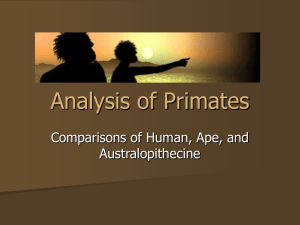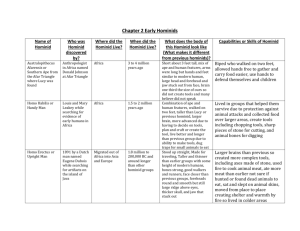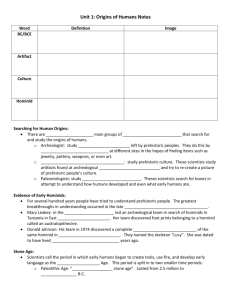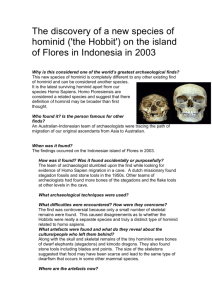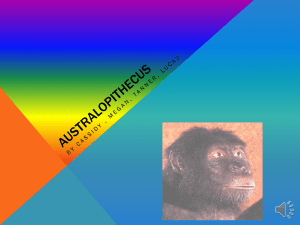Hominid paleo-milieu & diet
advertisement
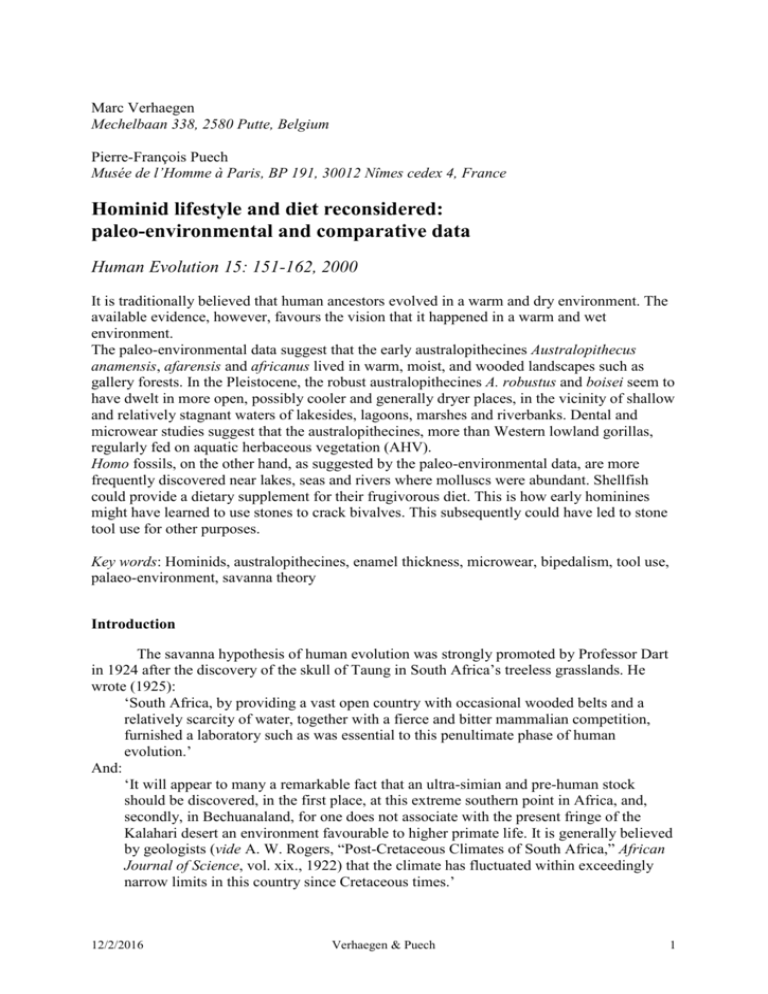
Marc Verhaegen Mechelbaan 338, 2580 Putte, Belgium Pierre-François Puech Musée de l’Homme à Paris, BP 191, 30012 Nîmes cedex 4, France Hominid lifestyle and diet reconsidered: paleo-environmental and comparative data Human Evolution 15: 151-162, 2000 It is traditionally believed that human ancestors evolved in a warm and dry environment. The available evidence, however, favours the vision that it happened in a warm and wet environment. The paleo-environmental data suggest that the early australopithecines Australopithecus anamensis, afarensis and africanus lived in warm, moist, and wooded landscapes such as gallery forests. In the Pleistocene, the robust australopithecines A. robustus and boisei seem to have dwelt in more open, possibly cooler and generally dryer places, in the vicinity of shallow and relatively stagnant waters of lakesides, lagoons, marshes and riverbanks. Dental and microwear studies suggest that the australopithecines, more than Western lowland gorillas, regularly fed on aquatic herbaceous vegetation (AHV). Homo fossils, on the other hand, as suggested by the paleo-environmental data, are more frequently discovered near lakes, seas and rivers where molluscs were abundant. Shellfish could provide a dietary supplement for their frugivorous diet. This is how early hominines might have learned to use stones to crack bivalves. This subsequently could have led to stone tool use for other purposes. Key words: Hominids, australopithecines, enamel thickness, microwear, bipedalism, tool use, palaeo-environment, savanna theory Introduction The savanna hypothesis of human evolution was strongly promoted by Professor Dart in 1924 after the discovery of the skull of Taung in South Africa’s treeless grasslands. He wrote (1925): ‘South Africa, by providing a vast open country with occasional wooded belts and a relatively scarcity of water, together with a fierce and bitter mammalian competition, furnished a laboratory such as was essential to this penultimate phase of human evolution.’ And: ‘It will appear to many a remarkable fact that an ultra-simian and pre-human stock should be discovered, in the first place, at this extreme southern point in Africa, and, secondly, in Bechuanaland, for one does not associate with the present fringe of the Kalahari desert an environment favourable to higher primate life. It is generally believed by geologists (vide A. W. Rogers, “Post-Cretaceous Climates of South Africa,” African Journal of Science, vol. xix., 1922) that the climate has fluctuated within exceedingly narrow limits in this country since Cretaceous times.’ 12/2/2016 Verhaegen & Puech 1 While we now known that the South African climate did change since the time of Taung (Partridge, 1985), Dart was thus convinced that the present and the ancient environment did not differ significantly and that the Taung child had lived in such open grasslands. Dart only got recognition a few decades later. Piltdown Man (rather big brain and big teeth) was unmasked as a fraud and anthropologists accepted the Taung fossil (small brain, small teeth) as a more likely link between apes (small brain, big teeth) and humans (big brain, small teeth). However, they not only accepted Dart’s view on Taung’s affinity, but also his view on Taung’s lifestyle in a dry and open country. While many anthropologists today no longer automatically follow the savanna hypothesis (e.g. Tobias, 1995; Wood, 1996), the idea remains unquestioned in most popular books. However, a savanna past of humans is comparatively and physiologically improbable, since humans in most respects differ from savanna-dwellers (e.g. Schmidt-Nielsen, 1979; Morgan, 1982, 1990; Verhaegen, 1991, 1997). In a comparison of humans with apes, arboreal, semi-aquatic, fully aquatic and savanna mammals (Verhaegen, 1993), not one feature distinguishing the savanna mammals was found in humans. Mammals of dry, warm and open landscapes are relatively independent of drinking-water and water-containing nourishment, have a high tolerance of dehydration and radiation heat, have high diurnal body temperatures and high daily temperature fluctuations, and high renal concentration power. They usually have very large external ears, a slender build, and running velocities of 30 miles per hour and more. They are unguli- or digitigrade, not plantigrade like opossums, bears, racoons, eared seals or African hominoids. Most of them do not have dextrous hands like racoons, many otters and primates. They never have abundant fat tissues under the skin like humans, but protect themselves from the sun with fur (or with dust coverings in elephants or rhinoceroses). Their vocalisations are less varied than those of dolphins, otters or primates are. They never copulate face to face as some slow branch-hangers (sloths, pottos, orangutans), marine mammals (cetaceans, sirenians) and humans do. All have an excellent sense of smell, as opposed to many marine mammals and humans. Most of them grow up fast and reach adulthood in less than three years. They often sustain body temperatures of more than 40°C (Grant’s gazelle can maintain 46°C for many hours) and show temperature fluctuations of more than 6° between day and night. Their urine concentration can be twice that of humans and more. They can bear a dehydration of 20 per cent, whereas in humans a dehydration of more than 10 per cent is fatal without medical intervention. They are very conservative with salt and water (many savanna mammals, even carnivores like the fennec fox, do not need drinking-water), and they never sweat ten to fifteen litres a day as humans can do in hot environments (hunting-dogs and many other savanna-dwellers do not sweat at all). Recently, anthropologists are appreciating these data: ‘physiologically, biochemically and histologically, we should be hopeless as savanna-dwellers. All of the former savanna supporters must swallow our earlier words’ (Tobias, 1995). Since humans differ strongly from such animals, a thorough reconsideration of the available fossil data is necessary. Our discussion will be mainly based on the paleo-environmental evidence and on the dental and microwear evidence of hominids. Paleo-milieu Not only the Taung cranium, but most hominid fossils - from a time span covering at least the last six million years - have been found in varied, but consistently wet environments: in humid forested areas or in the immediate proximity of abundant water collections at the time. However, there are the well-known difficulties of paleo-ecological reconstructions (Shipman & Harris, 1988): ‘taphonomic events […] may selectively destroy or distort the 12/2/2016 Verhaegen & Puech 2 fossil record and the association among species’; animals ‘may stray out of their preferred habitats into other areas’; ‘habitats are often complex and mosaic’; ‘ecological zones or habitats [migrate] across basins in response to climatic and other fluctuations’; and, most importantly, ‘depositional variables […] bias the fossil record by sampling a disproportionate number of habitats related to water (e.g. lake margins, streams, channels, deltas) and by failing to sample many open-country habitats farther away from water sources’. Indeed, that many hominid fossils have been discovered in such places by no means proves that they actually lived there. However, it certainly does not exclude it. The following list confirms the comparative evidence that it is rather improbable that the hominids ever lived in a savanna milieu, and provides a more shaded picture. Lukeino KNM-LU 335 “pre-australopithecine”: ‘The red beds seems to contain marginal lacustrine deposits as indicated by the presence of algal mats and lacustrine bivalves (including complete specimens with valves in the closed position)’ (Pickford, 1975). Tabarin KNM-TH 13150 “pre-australopithecine”: ‘The fauna includes aquatic animals such as molluscs, fish, turtles, crocodiles, and hippotami, along with others that might be found in the vicinity of a lake of river’ (Ward & Hill, 1987). Ardipithecus ramidus: ‘Sedimentological, botanical and faunal evidence suggests a wooded habitat for the Aramis hominids […] Aquatic elements (turtle, fish, crocodile) are rare. Large mammals (hippopotamus, proboscideans, rhinos, equids, giraffids, bovines) are rare. Primates are very abundant’ (WoldeGabriel et al., 1994); ‘[…] interpreted to have been a closed woodland. At Aramis, aquatic species and large mammals are rare, and colobines make up over 30% of all vertebrate specimens collected’ (Leakey et al., 1995). Kanapoi KNM-KP 29281 Australopithecus anamensis: Fish, aquatic reptiles, kudus and monkeys are prevalent. ‘A wide gallery forest would have almost certainly been present on the large river that brought in the sediments’ (Leakey et al., 1995). Chad KT 12 A. cf. afarensis: ‘The non-hominid fauna contains aquatic taxa (such as Siluridae, Trionyx, cf. Tomistoma), taxa adapted to wooded habitats (such as Loxodonta, Kobus, Kolpochoerus) and to more open areas (such as Ceratotherium, Hipparion) […] compatible with a lakeside environment’ (Brunet et al., 1995). Garusi-Laetoli L.H. A. anamensis or afarensis: Teeth and mandible fragments, the hardest skeletal parts which are frequently left over by carnivores (Morden, 1988), come from wind-blown and air-fall tuffs (Leakey et al., 1976). Cercopithecine and colobine monkeys are present (Protsch, 1981; Leakey et al., 1976). Hadar, Afar Locality: ‘Generally, the sediments represent lacustrine, lake margin, and associated fluvial deposits related to an extensive lake that periodically filled the entire basin’ (Johanson et al., 1982) Hadar AL.333 A. afarensis: ‘The bones were found in swale-like features […] it is very likely that they died and partially rotted at or very near this site […] this group of hominids was buried in streamside gallery woodland’ (Radosevich et al., 1992). Hadar AL.288 gracile A. afarensis: Lucy lay in a small, slow moving stream. ‘Fossil preservation at this locality is excellent, remains of delicate items such as crocodile and turtle eggs and crab claws being found’ (Johanson & Taieb, 1976). Makapan A. africanus: ‘[…] very different conditions from those prevailing today. Higher rainfall, fertile, alkaline soils and moderate relief supported significant patches of subtropical forest and thick bush, rather than savannah. Taphonomic considerations […] suggest that sub-tropical forest was the hominins’ preferred habitat rather than grassland or bushveld, and the adaptations of these animals was therefore fitted to a forest habitat’ (Rayner et al., 1993; see also Reed, 1993; and Wood, 1993). 12/2/2016 Verhaegen & Puech 3 Taung australopithecine: ‘the clayey matrix from which the Taung cranium was extracted, and the frequent occurrence of calcite veins and void fillings within it (Butzer, 1974, 1980) do suggest a more humid environment during its accumulation’ (Partridge, 1985). Sterkfontein A. africanus and Swartkrans A. robustus: Many South African australopithecines are discovered in riverside caves, presumably often filled with the remainders of the consumption process of large felids (Brain, 1981). Kromdraai: A. robustus was found near grassveld and streamside or marsh vegetation, in the vicinity of quail, pipits, starlings, swallows, and parrots, lovebirds and similar psittacine birds (T. N. Pocock in Brain, 1981). Turkana KNM-ER 17000 and 16005: A. aethiopicus was discovered near the boundary between overbank deposits of large perennial river and alluvial fan deposits, amid waterand reedbucks (Walker et al., 1986). Lake Turkana: ‘The lake margins were generally swampy, with extensive areas of mudflats […] Australopithecus boisei was more abundant in fluvial environments, whereas Homo habilis was rare in such environments […] Australopithecus fossils are more common than Homo both in channel and floodplain deposits. The gracile hominids […] seem to be more restricted ecologically to the lake margin than are the robust forms’ (Conroy, 1990). Ileret A. boisei: ‘the fossil sample reflects climatic and ecological environmental conditions differing significantly from those of the present day. At Ilerat, 1.5 Myr ago, climatic conditions must have been cooler and more humid than today, and more favourable to extensive forests […] The prominence of montane forest is particularly striking […] dominated by Gramineae and Chenopodiaceae appropriate to the margins of a slightly saline or alkaline lake’ (Bonnefille, 1976). Konso A. boisei: ‘The highly fossiliferous sands at the mid-section of KGA10 are interpreted to be the middle to distal portions of an alluvial fan, deposited adjacent to, and extending into, a lake. Fossils and artefacts deriving from horizons of sands and silts are not abraded and show evidence of minimal transport. A large mammalian assemblage has been collected from the deposits, showing a striking dominance of Alcelaphini […] to indicate the presence of extensive dry grasslands at KGA10’ (Suwa et al., 1997). Chesowanja A. boisei: ‘The fossiliferous sediments were deposited in a lagoon […] Abundant root casts […] suggest that the embayment was flanked by reeds and the presence of calcareous algae indicates that the lagoon was warm and shallow. Bellamya and catfish are animals tolerant of relatively stagnant water, and such situation would also be suitable for turtles and crocodiles’ (Carney et al., 1971). Olduvai middle Bed I: A. boisei O.H.5 as well as habilis O.H.7 and O.H.62 were found in the most densely vegetated, wettest condition, with the highest lake levels (Walter et al., 1991), near ostracods, freshwater snails, fish, and aquatic birds (Conroy, 1990); ‘[…] the middle Bed-I faunas indicate a very rich closed woodland environment, richer than any part of the present-day savanna biome in Africa […]’ (Fernández-Jalvo et al., 1998). ‘Fossilized leaves and pollen are rare in the sediments of Beds I and II, but swamp vegetation is indicated by abundant vertical roots channels and casts possibly made by some kind of reed. Fossil rhizomes of papyrus also suggest the presence of marshland and/or shallow water’ (Conroy, 1990). ‘[…] Cyperaceae fruits were common in H. habilis habitat (Bonnefille, 1984). Ancient Egyptians ate Cyperus papyrus root which was also present at Olduvai in swamp-margins and river banks’ (Puech, 1992). Olduvai O.H.24 habilis: ‘Crocodile remains predominate among the faunal material from this site and more than 2,000 teeth were found. Tortoise plates, shells of Urocyclid slugs, fish vertebrae and scales, bird bones and pieces of ostrich eggshell were also relatively common (Leakey et al., 1971). 12/2/2016 Verhaegen & Puech 4 Malawi UR 501 early Homo: ‘The Plio-Pleistocene Chiwondo Beds of Northern Malawi have yielded molluscs and fragmented remains of fish, turtles, crocodiles and large mammals […] Microvertebrates and carnivores are virtually unrepresented in the assemblage […] The general ecological setting of the Malawi Rift during the Late Pliocene was a mosaic environment including open and closed, dry and wet habitats, and which harbored a small and ecologically unstable paleolake Malawi’ (Schrenk et al., 1995). Chemeron KNM-BC1 early Homo: ‘The Fish Beds […] seem to be almost entirely lacustrine and fluviatile; fish remains are abundant […] Molluscs also lived in the lake, and locally their remains accumulate to form shelly limestones’ (Martyn & Tobias, 1967). Turkana Boy KNM-WT 15000 H. erectus: ‘Mammalian fossils are rare at this locality, the most abundant vertebrate fossils being parts of small and large fish. The depositional environment was evidently an alluvial plain of low relief […] Typical lacustrine forms (for example, ostracods, molluscs) could invade the area […] The only other fauna found so far in the fossiliferous bed are many opercula of the swamp snail Pila, a few bones of the catfish Synodontis and two fragments of indeterminate large mammal bone […]’ (Brown et al., 1985). Mojokerto H. erectus: ‘The basal part of the Putjangan Beds is composed of volcanic breccias containing marine and freshwater molluscs. The rest of the Putjangan Beds is composed of black clays of lacustrine origin’ (Ninkovich & Burckle, 1987). Peking H. erectus: ‘A big river and possibly a lake were located to the east and contained various water species; along the shorelines grew reeds and plants, which were home for buffalo, deer, otters, beavers and other animals’ (Poirier, 1978); ‘[…] accumulation in quiet water. The cave at this time was probably the locus of ponded water and was probably more open to the atmosphere’ (Weiner et al., 1998). Hopefield, Rabat & Terra Amata: H. erectus fossils came from sandstone made up from dune sand resting upon a former sea beach (De Lumley, 1990). In Terra Amata, ‘there are also indications that the inhabitants ate oysters, mussels and limpets – shells of which are present. The presence of fish bones and fish vertebrae indicate that the population also fished’ (Poirier, 1987). Australopithecine lifestyle The list shows that some very early hominids, more than later australopithecines, have been found near lacustrine molluscs (Lukeino and Tabarin ca. 6.5 and 5 Myr BP). Ardipithecus ramidus, supposedly another early hominid, must have lived in a wooded habitat, amid predominantly colobine monkeys (Aramis ca. 4.5 Myr BP). Pliocene australopithecines ca. 4-3 Myr BP apparently frequently dwelt in warm and humid, more or less closed environments (gallery forest or wooded habitat in Kanapoi, Chad, Hadar, Makapansgat, but inconclusive for Garusi-Laetoli). Pleistocene robust australopithecines since 2.5 Myr BP probably lived in generally dryer and more open landscapes (grassland in Kromdraai and Konso), but their remains lay in riverbanks, lagoons, marshes, lake-margins, near papyrus (Olduvai) and reed (Kromdraai, Olduvai, Chesowanja). Although ‘all nine Konso A. boisei specimens were recovered among the predominantly dry grassland fauna of KGA 10’ (Suwa et al., 1997), this does not mean that they lived in a savanna milieu, since ‘nearby subsites were also moist and wooded’ (Delson, 1997). Fragmentary fossils like those of Laetoli and Konso are often the remains of carnivore meals (Morden, 1988). Leopards, which preyed upon australopithecines, prefer to feed in dry 12/2/2016 Verhaegen & Puech 5 circumstances and therefore drag away their prey, sometimes several hundred meters (Brain, 1981). The preponderance of wet environments in our list is striking, but this was not considered to be inconsistent with a savanna view, because it was believed that the fossil record sampled a disproportionate number of habitats related to water (see the above citation from Shipman and Harris, 1988). To be sure, that the hominids have been discovered in humid or wet habitats does not allow firm conclusions about how much time they spent there, but the possibility that wetter rather than drier conditions influenced hominid evolution can not be ignored. Therefore, paleo-ecological data must be verified and supplemented through anatomical and especially dental studies of the fossils. It is generally agreed that all australopithecines have skeletal features of bipedality. Early graciles also show clear indications of tree climbing such as curved manual and pedal phalanges, though such features are less obvious in the robusts. Dental studies suggest that whereas gracile australopithecines preferred softer fruits and vegetables, the robusts’ diet included harder food items (e.g. Robinson, 1954; Du Brul, 1977; Walker, 1981; Puech, 1992; Lee-Thorp et al., 1994). Estimates of robust australopithecine bite force suggest ‘low-energy food that had to be processed in great quantities’ and food objects ‘hard and round in shape’ (Demes & Creel, 1988). Du Brul (1977) noticed dental parallelisms between the robust australopithecines and the bambooeating giant panda Ailuropoda melanoleuca (broad, high and heavy cheekbones, reduced prognathism and front teeth, broad back teeth, premolar molarisation), as opposed to gracile australopithecines, respectively non-panda bears. Papyrus and reed were present in the paleo-environment of the later australopithecines (e.g. Olduvai, Chesowanja, Kromdraai), and Cyperaceae and Gramineae are part of the diet of living African hominoids. Gorillas eat sedges and bamboo shoots and stalks, gorillas and chimpanzees eat cane, chimps and humans eat water lilies, and rice and other cereals are staple food for humans. Supplementing their diet with parts of grasslike plants might have been enabled the robusts to bridge the dry season, when fruits and soft vegetables were scarce. Studies of dental enamel microwear provide other details. In the early australopithecines of Garusi-Laetoli and Hadar (A. afarensis 4-3 Myr BP), the cheekteeth enamel has a polished surface and the microwear looks like that of the capybara Hydrochoerus hydrochaeris and that of the mountain beaver Aplodontia rufa (Puech et al., 1986). These animals are semi-aquatic rodents that feed mainly on sappy marsh and riverside herbs, grasses and bark of young trees. It has recently become clear that Western lowland gorillas G. g. gorilla spend some time eating aquatic herbaceous vegetation (AHV) like Hydrocharitaceae herbs and Cyperaceae sedges (Doran & McNeilage, 1997). Comparisons of molar enamel in South African fossils show that A. robustus ate substantially more hard food items than A. africanus (Grine & Kay, 1988). Incisal microwear suggests that A. robustus may have ingested foods that required less extensive incisal preparation than the foods consumed by A. africanus, such as fruits (Ungar & Grine, 1991), and ‘incisors need not be employed in the manipulation of hard objects’ (Ungar & Grine, 1989). The enamel of the East African robusts (Olduvai and Peninj) displays more pits, wide parallel striations and deep recessed dentine, resembling that of the beaver Castor fiber, that eats riverine and riverside herbs, roots of water lilies, bark and woody plants in a temperate climate. ‘Many food plants growing in marsh land and indeed many grasses, have high concentrations of siliceous particles known as opal phytoliths. The consumption of such foods produces a great deal of wear, and the enamel and dentine have a blunted appearance. Ancient Egyptians ate papyrus shoots (Puech et al., 1983b) and we suppose that [O.H.16] did the same with swamp margin plants’ (Puech, 1992). Whereas the East African robusts seem to have 12/2/2016 Verhaegen & Puech 6 had aquatic plants and papyrus shoots in their diet and ate more woody plants than the earlier australopithecines, habilis O.H.16 apparently supplemented the AHV of the earlier australopithecines with acid fruits (Puech, 1984). In the habilis cheekteeth, the margins of the striae have been polished and slightly etched, resembling the microwear of the coypu Myocastor coypus. This rodent feeds on reed, sedges, marsh plants, fruits and molluscs in river and lake margins. It thus seems that an early australopithecine diet of fruits (larger front teeth) and AHV (polishing) was supplemented with unripe fruits (acid etching) in habilis, and with woody plants in the robusts (more wear). The suggestion of Walker (1981) that A. boisei KNM-ER 406 and 729 were bulkeaters of whole fruits, ‘small, hard fruits with casings, pulp, seeds and all’, could explain the deep recessed occlusal dentine, but not the glossy appearance of heavily polished enamel, which is more typical for marsh plant feeders. In terrestrial grazers such as sheep, tooth wear is faster, with a different gradient and fabric-like grooves. These microwear data are consistent with the strontium/calcium ratios in Swartkrans fossils (Sillen, 1992). Apart from partial carnivory (rather unlikely with the robusts’ dentition, see Du Brul, 1977; Walker, 1981), Sillen provides two possible explanations for the low Sr/Ca of A. robustus: eating leaves and shoots of forbs and woody plants (kudu diet), and eating food derived from a wet microhabitat, for instance, from well-drained streamside soils. In our opinion, the coincidence of several independent lines of evidence (paleo-milieu, dental morphology, enamel microwear, Sr/Ca ratios) leaves little doubt that some or all australopithecines fed regularly on AHV growing in shallow waters, much more than Western gorillas do today (Chadwik, 1995; Doran & McNeilage, 1997). It is conceivable that hominid bipedality first arose in the shallow waters of gallery or mangrove or swamp forests. ‘One of the strong points about the aquatic theory is in explaining the origin of bipedality. If our ancestors did go into the water, that would forced them to walk upright’ (Stringer, 1997). That a gradual evolutionary transition from forest to marshland is possible is illustrated by the Western lowland gorillas that spend some time feeding on AHV, wading bipedally, sitting and playing in marshy forest clearings (Chadwik, 1995; Doran & McNeilage, 1997; NDR TV film, 1997). Hominine lifestyle A major distinction between fossil Australopithecus and Homo is the reduction of the last molar (from M1<M2<M3 to M1<M2>M3). This might have been the result of a new, cultural factor: the frequent use of stone tools by the Homo species. 2.5-Myr-old stone tools ‘are found in floodplain environments, close to margins of channels that carried the volcanic cobbles used as raw material for tool manufacture’ (Semaw et al., 1997). In other mammals, hard objects are used for opening shellfish or nuts. Sea otters Enhydra lutris crush shellfish with stones, chimpanzees Pan troglodytes use stones to crack nuts, mangrove capuchin monkeys Cebus apella apella use oyster shells as hammers to open oysters fixed to the roots and lower branches of mangrove trees (Fernandes, 1991). Homo species lived in places where freshwater or marine bivalves were more abundant (e.g. Chiwondo, Chemeron, “Turkana Boy”, Mojokerto, Terra Amata) than in the australopithecine habitats. Whereas Australopithecus appears to have lived near inland rivers and marshes, early Homo seems to have occupied also bivalve-rich areas such as mangrove forests and other seacoasts. This would explain the “sudden” appearance of Homo erectus-like people along the Indian Ocean and inland along the rivers. They colonised the Indian Ocean shores as far as Java perhaps as early as 2 Myr BP. In contrast with australopithecines, they must have crossed deep-water straits like those of Gibraltar and Flores (Morwood et al., 12/2/2016 Verhaegen & Puech 7 1998), and their remains have been found all over the Old World, from Indonesia to the Cape and England (e.g. seashore remains in Mojokerto, Hopefield, Rabat, Gesher Benot Ya’aqov, Terra Amata, Boxgrove). A dietary supplement of shellfish eating, perhaps only seasonal, could also help to explain the dramatic increase in brain size in Homo. It would have abundantly provided the elements essential for brain-growth. It has been claimed that the composition of the longchain poly-unsaturated fatty acids in tropical fish and shellfish is ‘more similar to that of the human brain than any other food source known’ (Broadhurst et al., 1998). Natura non facit saltum This “wet” scenario requires no great evolutionary steps. Forest-dwelling herbivores like capybaras, tapirs or pygmy hippos are partially adapted to the water collections in the tropical or subtropical rain or gallery or mangrove forests, but remain four-legged. In these shallow waters, primates - which, because of their arboreal history, have very mobile joints and a tendency to body erectness - easily adopt a bipedal stance and gait. Lowland gorillas go wading on their hind legs through swamps to get edible sedges and AHV (Chadwik, 1995; Doran & McNeilage, 1997). Proboscis monkeys Nasalis larvatus cross stretches of water on two legs to reach other mangrove trees (Morgan, 1997; Ellis, 1991). Japanese monkeys Macaca fuscata on islands walk bipedally into the sea (e.g. Morgan, 1997). In mangrove swamps, lower tree parts are occupied with bivalves, which are exposed at low tide (Fernandes, 1991). No doubt, inventive inhabitants of such places began to exploit these rich food sources, just as capuchin monkeys do, who feed on crustaceans and oysters. These relatively large-brained primates even use oyster shells to crack other oysters when no stones are available (Fernandes, 1991). Probably, human ancestors, who already cracked hardshelled nuts and fruits with stones, used pebbles as tools, at first for opening shellfish and later for processing other food sources like carcasses of hippopotamuses (e.g. Bunn, 1981). Once they mastered how to cut through skins with sharp stones or to use stone tools for processing wood, they would have seen new niches open to them, encouraging them to invade the inland along the rivers. Physiological data make it very probable that the phase of partial shellfish collection at one time included frequent diving (Schagatay, 1996). Today, human populations all over the world still collect shellfish or seaweed through diving. It could perhaps explain some human parallelisms with sea-mammals, according to the ideas of the so-called aquatic hypothesis of human evolution (Westenhöfer, 1924, 1942; Hardy, 1960; Morgan, 1982, 1990, 1997). Among these adaptations, those for diving and breath-holding (Schagatay, 1996), in combination with an older sound production as in many arboreal animals like gibbons (Darwin, 1871), could have led the basis for the voluntary and articulate sound production of human speech (Verhaegen, 1997). In this respect, Derek Ellis (personal communication) remarks ‘how well sound travels over water, compared to being muffled in forests, and even compared to grassland. Foraging beach and lagoon apes could separate quite widely and still remain in contact by vocalising’. Although both Australopithecus and Homo species seem to have dwelt at the edge between land and water, the differences in paleo-milieu, dentition, tool use and brain size suggest that both had different lifestyles. Nevertheless, there is a completely natural sequence of small behavioural innovations that could lead from early australopithecines to modern humans (points 2 to 5 are seen in chimps or gorillas, see Yamakoshi, 1998; Chadwik, 1995; Ellis, 1991; Nishida, 1980; Golding, 1972). frugi- and herbivory in tropical forests (all hominoids), 12/2/2016 Verhaegen & Puech 8 using stones to crack hard-shelled fruits and nuts, frugi- and herbivory also in forest clearings, plus “short”-legged bipedal wading in shallow waters, plus more frequent surface-swimming, wading and swimming also in mangrove forests, plus feeding on bivalves growing on lower tree parts, using shells or stones to crush shellfish, using stone tools for various purposes, colonising the seashores and rivers as omnivores, re-invasion of the land along the rivers, long-legged bipedalism on land. Conclusion The combination of comparative, physiological and paleo-environmental data makes a savanna evolution improbable, but does not exclude a temporary evolution of human ancestors and relatives at the edge between land and water. Many human features cannot be explained by a history of tree or forest dwelling alone, but find convergences in primates that live in mangrove areas, such as proboscis monkeys and some tufted capuchins. The paleoenvironmental and dental data suggest a gradual evolution, in strongly overlapping phases, from frugi- and herbivores in gallery or tropical or mangrove forests to “short”-legged bipedal waders in forest clearings or mangrove swamps, to omnivores and partial shellfish feeders along seacoasts and rivers, and finally to long-legged bipedalists on land. ACKNOWLEDGEMENTS - We wish to thank Roger Crinion, Elaine Morgan, Derek Ellis, Erika Schagatay, Charles Oxnard, Norman McPhail, Paul Crowley, Nicole Oser and Renato Bender for information or corrections. References Bonnefille R., 1976. Implications of pollen assemblages from the Koobi Fora Formation, East Rudolf, Kenya. Nature, 264: 403-407. Brain C. K., 1981. The Hunters or the Hunted? University of Chicago Press, Chicago. Brown F.H., Harris J. M., Leakey R. E. & Walker A., 1985. Early Homo erectus skeleton from west Turkana, Kenya. Nature, 316: 788-792. Brunet M., Beauvillain A., Coppens Y., Heintz E., Moutaye A. H. E. & Pilbeam D., 1995. The first australopithecine 2,500 kilometres west of the Rift Valley (Chad). Nature, 378: 273-275. Bunn H. T., 1981. Archaeological evidence for meat-eting by Plio-Pleistocene hominids from Koobi Fora and Olduvai Gorge. Nature, 291: 574-577. Chadwik D., 1995. Ndoki – last place on earth. National Geographic, 188: 2-45. Conroy G. C., 1990. Primate evolution. Norton, New York. Dart R. A., 1925. Australopithecus africanus, the man-ape of South Africa. Nature, 115: 195199. Darwin C., 1871. The Descent of Man, and Selection in Relation to Sex. John Murray, London. De Lumley H. & De Lumley M.-A., 1990. De Homo erectus verovert de Oude Wereld. In (Y. Coppens, ed.) Vijf miljoen jaar menselijk avontuur, pp. 46-67. Paleis Schone Kunsten, Brussels. 12/2/2016 Verhaegen & Puech 9 Demes B. & Creel N., 1988. Bite force, diet, and cranial morphology of fossil hominids. Journal of Human Evolution, 17: 657-670. Doran D. M. & McNeilage A., 1997. Gorilla ecology and behavior. Evolutionary Anthropology, 6: 120-130. Du Brul E. L., 1977. Early hominid feeding mechanisms. American Journal of Physical Anthropology, 47: 305-320. Ellis D., 1991). Is an aquatic ape viable in terms of marine ecology and primate behaviour? In (M. Roede, ed.). The Aquatic Ape - Fact or Fiction?, pp. 36-74. Souvenir, London. Fernandes M. E. B., 1991. Tool use and predation of oysters (Crassostrea rhizophorae) by the tufted capuchin, Cebus apella apella, in brackish water mangrove swamp. Primates, 32: 529-531. Fernández-Jalvo Y., Denys C., Andrews P., Williams T., Dauphin Y. & Humphrey L., 1998. Taphonomy and palaeoecology of Olduvai Bed-I (Pleistocene, Tanzania). Journal of Human Evolution, 34: 137-172. Golding R. R., 1972. A gorilla and chimpanzee exhibit at the University of Ibadan Zoo. International Zoo Yearbook, 12: 71-76. Grine F. E. & Kay R. F., 1988. Early hominid diets from quantitative image analysis of dental microwear. Nature, 333: 765-768. Johanson D. C. & Taieb M., 1976. Plio-Pleistocene hominid discoveries in Hadar, Ethiopia. Nature, 260: 293-297. Johanson D. C., Taieb M. & Coppens Y., 1982. Pliocene hominids from the Hadar Formation, Ethiopia (1973-1977), stratigraphic, chronologic, and paleoenvironmental contexts, with notes on hominid morphology and systematics. American Journal of Physical Anthropology, 57: 373-402. Leakey M. D., Clarke R. J. & Leakey L. S. B., 1971. New hominid skull from Bed I, Olduvai Gorge, Tanzania. Nature, 232: 308-312. Leakey M. D., Hay R. L., Curtis G. H., Drake R. E., Jackes M. K. & White T. D., 1976. Fossil hominids from the Laetoli Beds. Nature, 262: 460-462. Leakey M. G., Feibel C. S., McDougall I. & Walker A., 1995. New four-million-year-old hominid species from Kanapoi and Allia Bay, Kenya. Nature, 376: 565-571. Lee-Thorp J. A., van der Merwe N. J. & Brain C. K., 1994. Diet of Australopithecus robustus at Swartkrans from stable carbon isotopic analysis. Journal of Human Evolution, 27: 361-372. Martyn J. & Tobias P. V., 1967. Pleistocene deposits and new fossil localities in Kenya. Nature, 215: 476-480. Morden J., 1988. Towards a hominid taphonomy, carnivore consumption of human carcasses. American Journal of Physical Anthropology, 75: 251. Morgan E., 1982. The Aquatic Ape. Souvenir, London. Morgan E., 1990. The Scars of Evolution. Souvenir, London. Morgan E., 1977. The Aquatic Ape Hypothesis. Souvenir, London. Morwood M. J., O’Sullivan P. B. & Raza A., 1998. Fission-track ages of stone tools and fossils on the east Indonesian island of Flores. Nature, 392: 173-176. Ninkovich D. & Burckle L. H., 1978. Absolute age of the base of the hominid-bearing bed in Eastern Java. Nature, 275: 306-308. Nishida T., 1980. Local differences in reactions to water among wild chimpanzees. Folia primatologica, 33: 189-209. NDR TV film, 1997. Gorillas. Discovery Channel Pictures and Silverback Productions. Partridge T., 1985. Spring flow and tufa accretion at Taung. In (P. V. Tobias, ed.) Hominid Evolution, pp. 171-187. Liss, New York. 12/2/2016 Verhaegen & Puech 10 Pickford M., 1975. Late Miocene sediments and fossils from the Northern Kenya Rift Valley. Nature, 256: 279-284. Poirier F. E., 1987. Understanding Human Evolution. Englewood Cliffs, Prentice-Hall. Protsch R. R. R., 1981. Die archäologischen und anthropologischen Ergebnisse der KolhLarsen-Expeditionen in Nord-Tanzania 1933-1939. Band 4, 3., Tübinger Monographien zur Urgeschichte. Universität Tübingen, Tübingen. Puech P.-F., 1984. Acidic-food choice in Homo habilis at Olduvai. Current Anthropology, 25: 349-350. Puech P.-F., 1992. Microwear studies of early African hominid teeth. Scanning Microscopy, 6: 1083-1088. Puech P.-F., Cianfarani F. & Albertini H., 1986. Dental microwear features as an indicator for plant food in early hominids: a preliminary study of enamel. Human Evolution, 1: 507-515. Radosevich S. C., Retallack G. J. & Taieb M., 1992. Reassessment of the paleoenvironment and preservation of hominid fossils from Hadar, Ethiopia. American Journal of Physical Anthropology, 87: 15-27. Rayner R. J., Moon B. P., Masters J. C., 1993. The Makapansgat australopithecine environment. Journal of Human Evolution, 24: 219-231. Reed K. E., 1993. Building on the past: four million years or so of hominid evolution. South African Journal of Science, 89: 519-520. Robinson J. T., 1954. Prehominid dentition and hominid evolution. Evolution, 8: 324-334. Schagatay E., 1996. The Human Diving Response – Effects of Temperature and Training. University of Lund, Lund. Schmidt-Nielsen K., 1979. Desert Animals – Physiological Problems of Heat and Water. Dover, New York. Schrenk F., Bromage T. G., Gorthner A. & Sandrock O., 1995. Paleoecology of the Malawi Rift, vertebrate and invertebrate faunal contexts of the Chiwondo Beds, northern Malawi. Journal of Human Evolution, 28: 59-70. Semaw S., Renne P., Harris J. W. K., Feibel C. S., Bernor R. L., Fesseha N. & Mowbray K., 1997. 2.5-million-year-old stone tools from Gona, Ethiopia. Nature: 385, 333-336. ShipmanP. & Harris J. M., 1988. Habitat preference and paleoecology of Australopithecus boisei in Eastern Africa. In (F. F. Grine, ed.) Evolutionary History of the “Robust” Australopithecines, pp. 343-382. Aldine de Gruyter, New York. Sillen A., 1992. Strontium-calcium ratios (Sr/Ca) of Australopithecus robustus and associated fauna from Swartkrans. Journal of Human Evolution, 23: 495-516. Stringer C., 1997. Discussion. RSA Journal, November/December: 115. Suwa G., Asfaw B., Beyene Y., White T. D., Katoh S., Nagaoka S., Nakaya H., Uzawa K., Renne P. & WoldeGabriel G., 1997. The first skull of Australopithecus boisei. Nature, 389: 489-492. Tobias P. V., 1995. Lecture. University College London, November 14. Ungar P. S. & Grine F. E., 1989. Maxillary central incisor wear in Australopithecus and Paranthropus. American Journal of Physical Anthropology, 78: 317. Ungar P. S., & Grine F. E., 1991. Incisor size and wear in Australopithecus africanus and Paranthropus robustus. Journal of Human Evolution, 20: 313-340. Verhaegen M., 1991. Human regulation of body temperature and water balance. In (M. Roede, ed.) The Aquatic Ape – Fact or Fiction?, pp. 182-192. Souvenir, London. Verhaegen M., 1993. Aquatic versus savanna, comparative and paleo-environmental evidence. Nutrition and Health, 9: 165-191. Verhaegen M., 1997. In den Beginne was het Water. Hadewijch, Antwerp. 12/2/2016 Verhaegen & Puech 11 Walker A., 1981. Diet and teeth – dietary hypotheses and human evolution. Philosophical Transactions of the Royal Society London B, 292: 57-64. Walker A., Leakey R., Harris J. M. & Brown F. 1986. 2.5 Myr Australopithecus boisei from west of Lake Turkana. Nature, 322: 517-522. Walter R. C., Manega P. C., Hay R. L., Drake R. E. & Curtis G. H., 1991. Laser-fusion 40 Ar/39Ar dating of Bed I, Olduvai Gorge, Tanzania. Nature, 354: 145-149. Ward, S. & Hill A., 1987. Pliocene hominid partial mandible from Tabarin, Baringo, Kenya. American Journal of Physical Anthropology, 72: 21-37. Weiner S., Xu Q., Goldberg P., Liu J. & Bar-Yosef O., 1998. Evidence for the use of fire at Zhoukoudian, China. Science, 281: 251-253. Westenhöfer M., 1924. Das menschliche Kinn, seine Entstehung und anthropologische Bedeutung. Archiv für Frauenkunde und Konditionsforschung, 10: 239-262. Westenhöfer M., 1942. Der Eigenweg des Menschen. Berlin: Mannstaede. WoldeGabriel G., White T. D., Suwa G., Renne P., de Heinzelin J., Hart W. K. & Heiken G., 1994. Ecological and temporal placement of early Pliocene hominids at Aramis, Ethiopia. Nature, 371: 330-333. Wood B., 1993. Four million years of hominid evolution in Africa. Evolutionary Anthropology, 2: 117-119. Wood B., 1995. Apocalypse of our own making. Nature, 379: 687. Yamakoshi G., 1998. Dietary responses to fruit scarcity of wild chimpanzees at Bossou, Guinea: possible implications for ecological importance of tool use. American Journal of Physical Anthropology, 106: 283-295. Received September 30, 1998 12/2/2016 Accepted April 10, 1999 Verhaegen & Puech 12



